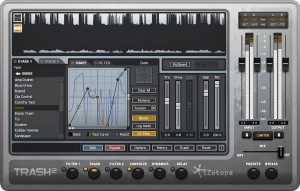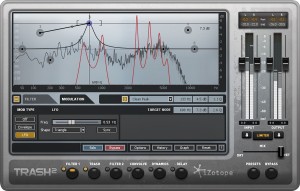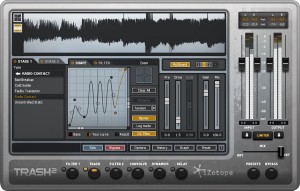Plugin Review: iZotope Trash 2
Today’s audio processors tend to fall into two broad categories: Those that try to recreate the past, and those that tire of it. iZotope’s new Trash 2 plugin falls squarely in that second camp.
iZotope released the original Trash plugin in back in 2003, and it was marketed as a multi-band distortion unit.
The new version, nearly 10 years in the making, is less an update, and more a complete overhaul based on that same general theme of complete audio annihilation.
What It Does
Trash 2 is a multi-purpose sonic mangler, comprised of more than a half-dozen individual audio processors.
Rather than mimic a single piece of equipment, this plugin is an entire toolbox that would require at least a 3-foot-high rack of outboard gear if you wanted to even begin to replicate it in the physical world.
It can easily overdrive, pulverize, or otherwise radically re-morph your sounds. But used judiciously, and with help from a master wet/dry control, Trash 2 can also act as a subtle enhancer.
How it Does It
Although it’s marketed as sound distortion software, it’s hard to say which effect truly lies at the heart of this plugin, since each processing stage is so flexible and fully-realized.
Trash 2 consists of six discrete modules: Distortion (named “Trash”), Impulse Response Filters (called “Convolve”), Delay, Dynamics, and two separate Filters.
They can be placed in any order you desire, and then individually solo’d, muted, or combined.
The “Trash” Module
Trash 2 features more than 60 custom distortion algorithms that mimic everything from tape, tubes and fuzzboxes to AM breakup and the satisfying bit-smashing of a Nintendo Gameboy.
As with each processor that makes up Trash 2, the distortion module is almost endlessly customizable.
It offers the option to click and drag in order to create your own personal non-linearities, or to even assign different types of overdrive to each frequency band.
If you were so inclined, you might give your low end a little bit of subtle tube grit, while your high-end gets some tape-like saturation and your midrange is pulverized into smithereens of granular white noise.
Alternately, you could choose to saturate only a single band, for instance the high-end, effectively turning the Trash section into an aural exciter.
The “Convolve” module
The other uncommon component in Trash 2 is the “Convolve” section. It is a convolution or “impulse response” filter – the very same type of processing employed by many of today’s best software reverbs.
In order to lighten the CPU load (and to focus on what Trash does best) this plugin is loaded up with very short impulse responses that radically reshape tone rather than add long reverb tails.
The library comes packed with more than 100 IRs, dominated by things like guitar speakers, snare drums, wooden cabinets, and everyday household objects. There’s even a whole section of impulse responses culled from human vowel sounds and animal noises.
Ever wonder what that bass guitar would sound like re-interpreted through the snorts of a pig? Neither have I, but now we can find out.
It’s also worth noting that you can load your own samples, or even increase the maximum sample time of this section (provided you’re not too worried about CPU load) turning Trash into a convolution reverb unit on steroids.
The “Filter” Modules
Trash has two separate filter modules.
They are identical, and by default they appear both directly before and after the distortion module. Of course, you can move them anywhere in the chain that you like, or even arrange them in parallel rather than in series, if you prefer.
For me, this was among the most powerful and the most fun parts of Trash 2. I’d even say that you could just as easily call this “a filter plugin”.
Each of Trash’s filters offer six bands. Each of the bands can be assigned a filter curve from a list of more than 20 varieties.
You could, for instance, combine the low-pass filter of a vintage synthesizer with the low-shelf curve of a Pultec, and then add a midrange boost with one of the cleanest-sounding peaking filters you’re likely to hear.
The filter types are organized under names like “vintage”, “screaming” “clean”, and “saturated”, not one of which is misleading. There are even a couple of “vocal” filters than can give vowel-like tone and texture to your sounds
Some of these filters are so powerful, colorful, and ready to be pushed that I often found myself using just one or two of them to dramatically reshape tones. But what really impressed me most about this section were the filter modulations. This is where you can create wahs, tremolos and talk-box-like effects using LFOs of a variety of shapes and speeds. The modulations can also sync to the track’s dynamics or its tempo, and can even be triggered by a sidechain input.
The Delay Module
The delay module was another of my favorites. It’s not quite as full-featured as the other sections, but that’s only to say that iZotope stopped short of putting the kitchen sink into this one.
It might be nice to have a delay modulation or panning function built-in, but otherwise, pretty much any feature you’d want out of a good delay is in there.
There are a handful of delay degradation profiles based on things like tape machines, early digital delays, and there’s even one that sounds a bit like a Cooper Time Cube – an early analog device that used what was essentially a-garden-hose-in-a-box to delay signal.
They all sound surprisingly good (even when they are pushed to sound “bad”) and are endlessly fun to manipulate.
The degradation of each algorithm can be controlled with a separate “trash” fader, and there’s control for stereo width as well. The feedback circuit goes well past 100%, leading to instant dub-freakouts when desired.
The Dynamics Module
The multi-band dynamics module has just about everything in it that you could ask for in a basic digital compressor, sounds and works just fine.
For me, it is probably the least inspiring of the six modules. Of course, it is hard to keep pace with the over-the-top allure of all the other sections, each of which can be bogglingly powerful.
What I did like most about the dynamics section of Trash 2 was its fairly novel visual feedback. It shows gain reduction over time, overlaid on top of the waveforms of the source signal.
There’s no substitute for mixing with ones ears, but this could be a good learning tool for those learning to listen for the subtleties of different attack and release settings and slopes.
Finally the frequency-sensitive triggering of the dynamics section can come in handy when working with resonant filters, and a nice added touch is that a transparent limiter protects the final output stage. This allows you to crank up the saturation without worrying about unintended overloads or awkward gain-staging.
The GUI
At first, what I liked least about Trash was its spartan and dreary GUI.
But soon into demoing this plugin, I had a complete reversal of opinion, and came to find that the spare visual presentation was actually one of its greatest assets. It’s rare to find a plugin that fits in so many features and controls in such a logical and uncluttered way.
Due to the sheer depth and flexibility of the plugin, Trash 2 could easily run the risk of becoming overwhelming. But such care has been put into the layout that this potential risk never emerges as a genuine threat.
It’s surprisingly easy to find what you’re looking for in Trash and mouse-over text easily explains the few unfamiliar knobs. If you’re comfortable with computers and truly understand audio, you will “get” how to use each of the modules in this plugin very quickly.
What seemed like such an uninspiring monochrome at first glance ultimately turned out to be just the thing for such an experimental and tweakable plugin. As you find yourself lost in sounds after many minutes of stimulated tone-bending, the GUI seems to disappear.
On my system, the controls were so seamless and responsive that my cognitive mind was lulled to sleep, and it almost felt like I was able to reach out and sculpt pure, liquid sound. It’s a rare feat, but the plugin’s layout invites deep listening, even while providing so much visual feedback.
Major Uses
Trash 2 is a very specialized plugin.
Those who would benefit from it the most are likely to fall into one of two categories: Electronic Musicians, for whom this might be a thrilling tool that would find near-constant use, and Sound Designers, who craft new sonic environments and specials effects for film, television and video games.
For the EDM producers, Trash can warp samples, drum machines and synthesizers into molten, pulsating nuggets of hot twisted audio. Alternately, it can usher them into dripping, tripping, dreamlike spaces.
For sound designers, Trash can help sculpt unexpected ambiences and create horrific or sci-fi sound effects. It can also convincingly imitate a variety of phones, speakers and radio effects.
The only plugin to rival (and perhaps surpass) Trash on the latter front is Audioease’s Speakerphone, which takes a decidedly more literal and visual approach to replicating real-world devices. But it also costs more than twice as much.
At less than $200 street, Trash 2 may be a no-brainer for many EDM producers and post-production engineers. But creative engineers who work on more conventional recordings may find it valuable as well.
The speaker models in the “convolve” section, when coupled with the distortion algorithms of the “trash” module can make this plugin into a pretty convincing amp simulator.
As much as I’ve embraced digital, I still love working with real amplifiers, and so this has not been my favorite use of the plugin. I have liked Trash, however, as a distorter and reinforcer of drum breaks, bass-lines, instrumental leads and even vocals.
Patching into a chain of quirky old hardware boxes can be more fun, inspiring, and certainly makes for a better a story. But working with Trash is about as seamless and satisfying as things can get in the digital world.
For producers and engineers who tend to work on more straight-ahead recordings, this is the kind of plugin you might use once on every album, or perhaps once on every song, depending on your taste for experimentation.
For some, that will be satisfying enough to warrant the price of admission. For others it might not. That call is yours. A generous 10-day demo period makes it pretty easy to decide for yourself.
Quibbles and Qualms
Trash allows you to apply automation to any of its hundreds of parameters. It’s welcome functionality, but there’s one drawback: In my version of PT 10, I was unable to use the normal keyboard shortcuts to simply click the desired control, instantly enabling it for automation.
Instead, the only way to apply automation to the desired control was to go hunting for it in an enormous list of text — easily the largest I’ve ever seen.
This parameter list offers no search function (at least not in Pro Tools) but its entries are intelligently named and well-organized. This wasn’t enough to make that enormous list fun to scroll through, but it did make it possible.
If iZotope were to fix anything in a future update, this should be one of the first places to look.
My only other critique is that the delay module — which I really did enjoy — could be fleshed out just a bit, in order to help it keep pace with the remarkable power of all the other sections. A modulation option would be nice here, as well as complete control over stereo panning and the number of delayed repeats.
Otherwise, the plug-in easily succeeds at what it sets out to do. Whether or not that’s appealing to you is a question that can only be answered by demoing the product.
Final Verdict
I like Trash 2.
It is most certainly not a single-function plugin, and stands in stark contrast to all the faithful, one-off emulations of vintage compressors, fuzz boxes and EQs out there.

Trash 2 has intro pricing ($149) through Dec 6.
Of course, there is something to be said for the deliberate and considered approach of auditioning one vintage squeezebox or another and then moving on to the next sound. But there’s also something to be said about diving right into a project with an oversized swiss army knife, and seeing what you might come out with. That’s what Trash 2 is for.
Auditioning sounds on a plugin like Trash has absolutely nothing in common with debating which vintage of the same Bordeaux wine has a superior “bouquet”.
Instead, Trash presents you with clear and dramatic choices: Would you like a bold Cabernet with dinner or a nice light Pinot Grigio? Maybe the answer is “neither”, and what would really hit the spot would be a grape soda, a tomato juice, a Belgian ale, a sparkling water, or a Pabst Blue Ribbon.
Or perhaps: a fluorescent lime Hi-C spiked with vodka and red pepper flakes, then lit on fire and hurled at a passing automobile.
Now that’s what Trash 2 is all about.
Justin Colletti is a producer/engineer, professor and journalist who lives in Brooklyn. He is a regular contributor to SonicScoop and edits the musician magazine Trust Me, I’m a Scientist.
Please note: When you buy products through links on this page, we may earn an affiliate commission.











mixingforindies
December 10, 2012 at 10:47 am (11 years ago)Tanks Justin for letting us know about that what seems a really cool plug!
I have to check this.